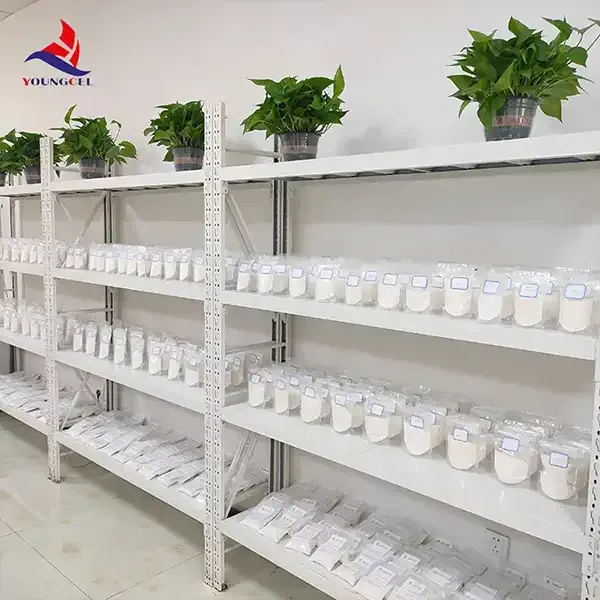HEC Cellulose Innovative Applications and Benefits
Hydroxyethyl cellulose (HEC) is a non-ionic cellulose ether derived from cellulose, a natural polymer obtained from plant cell walls. As a derivative of cellulose, HEC maintains many of the advantageous properties of its parent compound while also exhibiting unique characteristics that make it particularly valuable across a variety of industrial applications. From construction to personal care products, HEC plays a pivotal role in enhancing product performance and versatility.
Properties of HEC Cellulose
HEC is characterized by its excellent water solubility, rheological properties, and film-forming abilities. It is typically available in a powdered form that, when mixed with water, forms a clear, viscous solution. These properties are attributed to the hydroxyethyl groups introduced into the cellulose chain, which disrupt the strong hydrogen bonding that occurs in native cellulose. As a result, HEC has a lower viscosity at high shear rates, making it easier to handle during manufacturing processes.
Moreover, HEC is a stable compound that is resistant to heat and acids while being biodegradable and non-toxic, which aligns with the growing demand for environmentally friendly materials in various industries. Its thickening and emulsifying properties make it a popular choice for formulators looking to improve product consistency and stability without compromising performance.
Applications of HEC Cellulose
1. Construction Industry One of the most significant applications of HEC is within the construction sector, particularly in cement and mortar preparations. HEC acts as a thickening agent, enhancing open time and workability while preventing segregation of cementitious materials. Additionally, because it improves water retention and reduces cracking, HEC contributes to the durability and longevity of construction materials.
hec cellulose

2. Personal Care Products In the realm of cosmetics and personal care, HEC is widely used in products such as shampoos, conditioners, lotions, and gels. Its ability to create a smooth texture and suspend solids makes it ideal for formulating products with a pleasing feel and appearance. Moreover, HEC is an effective stabilizer for emulsions, ensuring that products maintain their intended consistency over time.
3. Pharmaceuticals HEC is also utilized in the pharmaceutical industry as a binder and excipient in tablet formulations. Its role in drug delivery systems is crucial, as it can control the release rate of active ingredients, enhancing bioavailability. Additionally, its non-toxic nature and compatibility with a variety of substances make it a reliable choice for formulators.
4. Food Products Another noteworthy application of HEC is in the food industry, where it serves as a thickening agent and stabilizer in various formulations. HEC can improve the texture and mouthfeel of products such as sauces, dressings, and ice creams, contributing to an enhanced sensory experience for consumers.
5. Agriculture In the agricultural sector, HEC finds use in the formulation of pesticides and herbicides. It helps to improve the adhesion and distribution of active ingredients on plant surfaces, enhancing their effectiveness while lowering the required application rates. This not only improves agricultural outcomes but also promotes sustainable practices by reducing chemical usage.
Conclusion
As an alternative to synthetic polymers, HEC cellulose represents a sustainable option that meets the rigorous demands of various industries. Its unique combination of properties—such as water solubility, stability, and biodegradability—positions it as a critical ingredient in the development of innovative products. Whether enhancing the performance of construction materials, formulating effective personal care products, or playing a role in sustainable agricultural practices, HEC cellulose is demonstrating its versatility and importance in today's industrial landscape.
Reflecting on HEC’s contributions, it is clear that as industries continue to evolve and prioritize sustainability, the role of natural polymers like HEC will only grow, leading to further advancements and applications that benefit both manufacturers and consumers alike. With ongoing research and development, the future of HEC cellulose looks promising, paving the way for new possibilities across diverse sectors. As we continue to discover and harness its full potential, HEC cellulose is sure to remain a cornerstone of innovation and sustainability in the years to come.
-
Rdp Powder: Key Considerations for Wholesalers in the Building Materials IndustryNewsJul.08,2025
-
Key Considerations for Wholesalers: Navigating the World of Hpmc - Based ProductsNewsJul.08,2025
-
Hpmc Detergent: Key Considerations for WholesalersNewsJul.08,2025
-
Key Considerations for Wholesalers: China Hpmc For Tile Adhesive, Coating Additives, Concrete Additives, and MoreNewsJul.08,2025
-
Crucial Considerations for Wholesalers: Navigating the World of Construction MaterialsNewsJul.08,2025
-
Key Considerations for Wholesalers Sourcing Additive For Cement, Additive For Concrete, Additive For Putty from Additive Manufacturer Shijiazhuang Gaocheng District Yongfeng Cellulose Co., Ltd.NewsJul.08,2025




